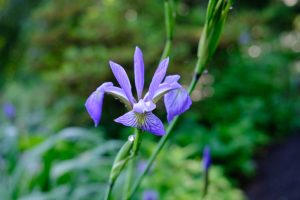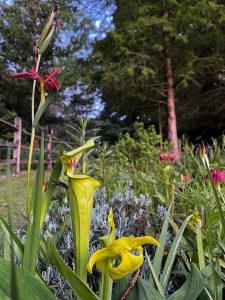Backyard Bogs
Images courtesy of Nate Braddock, Chris Swisher and Jenkins Arboretum & GardensBring strange and wonderful wetland plants into your home garden
 The word “bog” tends to evoke images of stagnant, forbidding mires with nothing to offer besides a sulfurous stench and muddy boots.
The word “bog” tends to evoke images of stagnant, forbidding mires with nothing to offer besides a sulfurous stench and muddy boots.
What many people don’t realize, though, is these often-overlooked wetlands serve as soggy sanctuaries for a vast suite of otherworldly plants. The harsh environmental conditions of bogs have driven botanical residents to evolutionary extremes. Consequently, traversing the mossy grounds of a bog can bring you face to face with delicate orchids, tart cranberries and vicious carnivorous plants.
Luckily, you don’t need to be a world-class explorer to enjoy the bounties of a bog. The conditions needed to grow native wetland plants are easy to replicate in a home garden. With just a few common supplies and some elbow grease, you can create your own easy-to-maintain mini-bog.
What’s a Bog?

At its most basic definition, a bog is an acidic, nutrient-poor wetland. Bogs can form in a variety of ways, but they tend to be dominated by low-growing sphagnum moss (Sphagnum spp.), resulting in an open, sunny environment. Beneath the top layer of moss lies layers of peat — a light, spongy, carbon-rich material made up of partially decomposed sphagnum. Peat serves as the foundation for all plant life in wild bogs, just as it will in your home bog.
Unfortunately, wetland habitats and the plants that live in them are in decline as human development encroaches upon the wild. In light of this decline, your home bog garden can not only display a palette of unusual plants, but it can safeguard plant biodiversity.
Build-a-Bog

The success of a home bog garden comes down to emulating four key features of natural bogs: constant moisture, full sun, an acidic, peat-based medium and a low nutrient content.
For the base of your bog, choose a wide, watertight container 10 to 18 inches deep. Stick to nonporous materials like plastic or steel to prevent moisture from leaving the system. Bog plants like wet roots, but they don’t enjoy having their crowns flooded. To prevent flooding, use a drill to create eight to 12 evenly spaced, small drainage holes two inches below the lip of the container.
Next, a decision. For a more naturalistic look, sink your container into the ground, leaving a one-inch lip to prevent groundwater from flowing into your bog. For a more portable option, keep your bog above ground as an accent container in your garden. Wherever you choose to place your bog, make sure it’s in an open area where it will get at least six hours of direct sun every day.
With the perfect site selected, fill your container with a 50:50 mix of pure sphagnum peat and sand. Unlike a typical garden container, the media in your bog container should be compacted as much as possible to eliminate any air pockets.
Once filled, water the contents and let it settle for at least 48 hours, topping off with additional material as needed.
Bog Plants for the Home Garden
Carnivorous plants of the United States grow almost exclusively in bogs. Coming in an astounding variety of shapes and colors, these plants could easily be used to create a whole mini-bog dedicated to these fascinating plants.

For example, the golden trumpets of the yellow pitcher plant (Sarracenia flava) stand tall over the short and stout purple pitcher plant (Sarracenia purpurea). Both lie in repose, awaiting the next insect that’s lured into the trap of their conical-shaped leaves.
Venus flytraps (Dionaea muscipula), one of the most instantly recognizable plants, is endemic to a very small boggy area that bridges the Carolinas. This plant is marginally hardy in Southeast Pennsylvania, so it benefits from being around the base of larger plants, where its active traps are sheltered from cold winds.
Though the charismatic carnivores tend to steal the show, they’re beautifully complemented by an assortment of wetland wildflowers. Ladies’ tresses (Spiranthes spp.) are orchids with a prolific growth habit. Fragrant spikes laden with small, white flowers stand tall and strong from late summer into early spring.
For a shocking contrast, plant ladies’ tresses alongside cardinal flower. Cardinal flower blooms throughout summer with fiery red flowers that hummingbirds love to visit. For gardeners with a case of the blues, a bog is the perfect place to grow northern blue flag iris (Iris versicolor). Its showy violet flowers are held aloft over a fan of strappy blue-green foliage that adds a beautiful texture to any mini-bog.
Though you may have to search harder for bog plants, they’re readily available from specialty nurseries, both online and in person. Some can be found in The Garden Shop at Jenkins Arboretum & Gardens.
Bog Maintenance

To keep your bog container healthy, it’s important to maintain consistent moisture while limiting the addition of minerals and nutrients like nitrogen and phosphorus. Carnivorous plants can be picky about high nutrient content, so it’s important to avoid fertilizing your bog.
With regular rainfall, your bog container should be more or less self-sustaining. In times of drought or especially hot days, the bog may require supplemental watering. Water from a garden hose can introduce unwanted minerals to the system, so it’s best to water your bog with distilled water or water from a rain barrel.
Ultimately, a bog garden teaches us to find wonder in the most unexpected places. So build your bog, sit back and have fun discovering something new about the natural world in every corner of your soggy masterpiece!
Jenkins Arboretum & Gardens is a 48-acre public garden showcasing native flora of the eastern United States and a world-class collection of rhododendrons and azaleas. The gardens are open every day of the year and are always free admission. Plan your visit by going to the website at JenkinsArboretum.org.
Our Favorite Resources
- Ball & Ball
- Berk Hathaway Country Properties
- Berk Hathaway Holly Gross
- Berk Hathaway M. Schwartz
- Canvas Valley Forge
- Closet Factory
- Dewson Construction
- DiSabatino Landscaping
- Homestead Structures
- King Construction
- Main Street Cabinet
- McComsey Builders
- Monument/Sotheby’s Int’l
- Mostardi Nursery
- Renewal Dynamics
- Sheller Energy
- White Horse Construction
